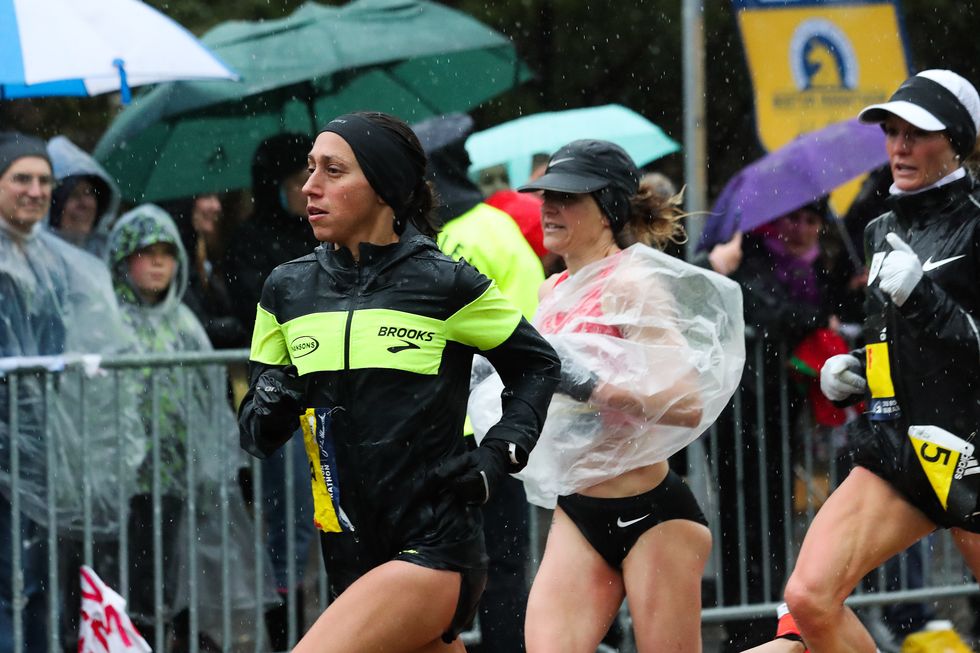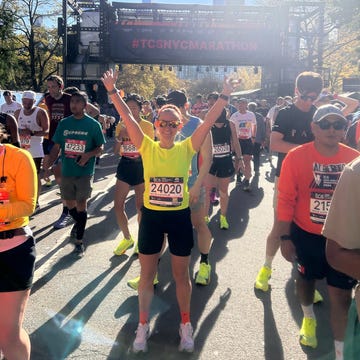There are a lot of things that make Desiree Linden’s victory at the 2018 Boston Marathon a race story for the ages. There’s the headline you’ve been seeing everywhere: She’s the first American woman to win the race in over three decades! And if you saw even a single picture taken on Marathon Monday, you know that she ran in some of the worst weather in the race’s history. (In case you didn’t, here are 15 pictures that captured the 2018 Boston Marathon.)
Then, there’s the comeback component: Linden was two seconds away from victory at the 2011 Boston Marathon, and she considered quitting (yes, quitting) Monday’s race. “Early on, I was feeling horrible,” Linden said. “I gave [Shalane Flanagan] a tap and said, ‘There’s a really good chance I’m going to drop out today. If you need anything—block the wind, adjust the pace maybe—let me know.’”
So when Flanagan took a now-famous bathroom break near Wellesley College (around the halfway point), Linden slowed down so they could catch up to the rest of the elites together.
“When you work together, you never know what’s gonna happen,” Linden said. “Helping her helped me, and I kind of got my legs back from there.”
How Linden Went from Almost-Quitting to Winning
Linden might be on to something. “Your brain releases endorphins, dopamine, and serotonin when you help someone,” says Nicole Detling, Ph.D., sports psychologist and assistant professor at the University of Utah. And these are all great hormones to have during a race: Endorphins have a morphine-like way of reducing pain, according to the Hawaii Medical Journal; dopamine increases motivation and focus, and serotonin boosts your mood, says Detling. “I have no doubt that this surge of hormones helped Linden turn the race around.”
There’s also a potential hit of oxytocin. “Your brain releases oxytocin when you feel a bond with another person,” Detling says. And this bond reminds you that you’re not alone in your suffering: “It helps you focus on the bigger picture, not just how bad you feel in the moment.” (Linden basically confirmed this herself: “Today was bigger than one person,” she said post-race. “It was really all of us pushing each other.”)
Dave Paskevich, Ph.D., associate dean and associate professor of sport psychology at the University of Calgary in Canada, says this is a classic example of disassociation, which essentially means Linden may have stopped thinking about how much the race sucked and started thinking beyond the pain.
“Associative thinking means you’re thinking about performance like evaluating your form and tracking your pace,” says Paskevich. When Linden shifted her focus from wanting to win the race to wanting to help Flanagan, she switched to dissociative thinking, which can reduce the perception of fatigue, he explains. Note: This is exactly why you suddenly feel better when your favorite song comes on; you’re simply not paying attention to the discomfort anymore.
Plus, “focusing on Flanagan, even briefly, could have helped Linden find her rhythm without the pressure of feeling like she needed to win,” Paskevich says. That matters, because pressure isn’t always good for performance. Research has shown that baseball players are more likely to strike out when they’re under pressure to perform well.
How You Can Replicate These Effects During Your Next Race
Of course, not all of us are in the position to help Shalane Flanagan when we need a mid-race pick-me-up. But there are easy ways to score a similar boost at any level.
“Anything that helps you feel more connected to other people will boost your mood and performance,” Detling says. “That might mean cheering on a runner who’s struggling or giving a spectator a high-five.”
It’s important to note that this hormone surge is temporary, so it’s up to you to capitalize on it. “The initial surge of hormones only lasts about six seconds, but you get to choose what happens next,” Detling says. “You can embrace the positivity for the rest of the race or go back to focusing on the pain.” (Guess which one she suggests?)
You can also shift the way you see your goals, especially when the conditions are as bad as they were in Boston on Monday. “There are outcome goals (winning, PRing) and process goals (nailing your technique),” Paskevich says. “A lot of athletes obsess over the outcome, but the truth is, you have much more control over the process.”
Don’t worry, we’re not telling you to stop striving for a specific time, or even a victory if you’re at Linden’s level, but you should be able to shift your expectations when conditions call for it. “If you’re not meeting the goals you set for yourself, pressure can be an anchor that drags you down,” Paskevich says. “Linden was able to run more freely when she gave herself permission to look beyond her original goal.”
In the end, Linden’s sportsmanship takes nothing away from her achievement: No matter who she helped, it was still her heart, her legs, and her tactics that carried her across that finish line first. But her ability to look out for others during such a significant event speaks volumes about her character—and that surely makes this historic victory that much sweeter.














